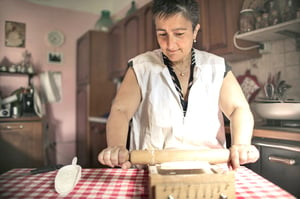Dig back into your childhood memory, and you'll recall your mother telling you to stop fidgeting...
What Are ADLs (Activity of Daily Living)?
Older adults and their families quickly learn senior living involves a lot of acronyms. "ADL" stands out as one of the most common. ADL means Activities of Daily Living. These are necessary day-to-day activities a person should be able to accomplish independently.
Basic ADLs
Basic ADLs are activities aimed at meeting a person's basic physical needs:
-
Dressing
-
Grooming
-
Toileting
-
Transferring bed/chair
-
Climbing stairs
-
Eating
As they age, older adults may begin to experience difficulty in handling some of these fundamental actions. As indicated by the chart below from the 2011 United States National Health Interview Survey, 1 in 5 adults age 85 or older needs help with at least one ADL:
|
Age Range |
Need help with 1 or more ADL |
|
56-74 |
3.4% |
|
75-84 |
7.0% |
|
85 and over |
20.7% |
There are many possible reasons an older adult might need help with an ADL:
-
Physical health
-
Medication reactions
-
Home environment
It commonly occurs that after an inpatient hospital stay, many older adults need more help with basic ADLs than before entering the hospital.
Instrumental ADLs
Another type of ADL, Instrumental Activities of Daily Living (IADL), focuses on higher-level activities:
 Shopping
Shopping- Cooking
- Managing medications
- Communicating via phone or mail
- Doing housework
- Doing laundry
- Driving or using public transportation
- Managing finances
IADLs focus on living independently in a community.
How are ADLs Measured?
The concept of ADLs originated in the 1950s. Since that time, checklists have been developed for basic and instrumental ADLs. These checklists are used in hospitals, clinics, and senior living facilities to assess the degree of assistance required by older adults. In one checklist, the Lawton Instrumental Activities of Daily Living (IADL) Scale, eight domains of function are evaluated on a scale from 0 (low function, dependent) to 8 (high function, independent).
ADL measurements help healthcare providers decide what level of care is necessary to help older adults live as independently as possible. Appropriate interventions can slow or prevent problems that could drive an increased need for ADL support. For example, those experiencing difficulty walking present a risk for falls. An intervention like a walker could not only promote overall well-being, but it could also avoid unnecessary healthcare costs.
Other uses for ADL assessments are determining benefits for commercial disability insurance and long-term care insurance policies as well as input for Medicare and Medicaid aid formulas. Home healthcare providers use ADL measurements to understand the resources and level of care needed to support their clients' desires to remain their own homes.
ADLs and the Care Team
ADLs are a vital support for healthcare professionals to communicate effectively on behalf of older adults. These caregivers may include:
 Case Manager, Nurse, and Social Worker
Case Manager, Nurse, and Social Worker- Primary care Physician
- Home health or Skilled nursing Agencies
- Physical and Occupational Therapy
- Long Term Care Insurance Providers
- Government Agencies
A nurse or care manager usually perform the ADL assessment. The results can then be shared with the rest of the team so that care can be delivered consistently with common goals in mind. Given a mutual understanding of the older adult's status, therapies and other interventions can be designed to aim at the same intended outcome.
Initial ADL assessments also serve as baselines against which future measures can be compared. Changes to the care plan are based on changes in ADL status. In this way, the changes in an older adult's abilities can be tracked closely over time, thereby providing cues for making modifications to provide the right level of care at the right time.
Visit our Long-term Care Resources page for more helpful content about planning for care!







